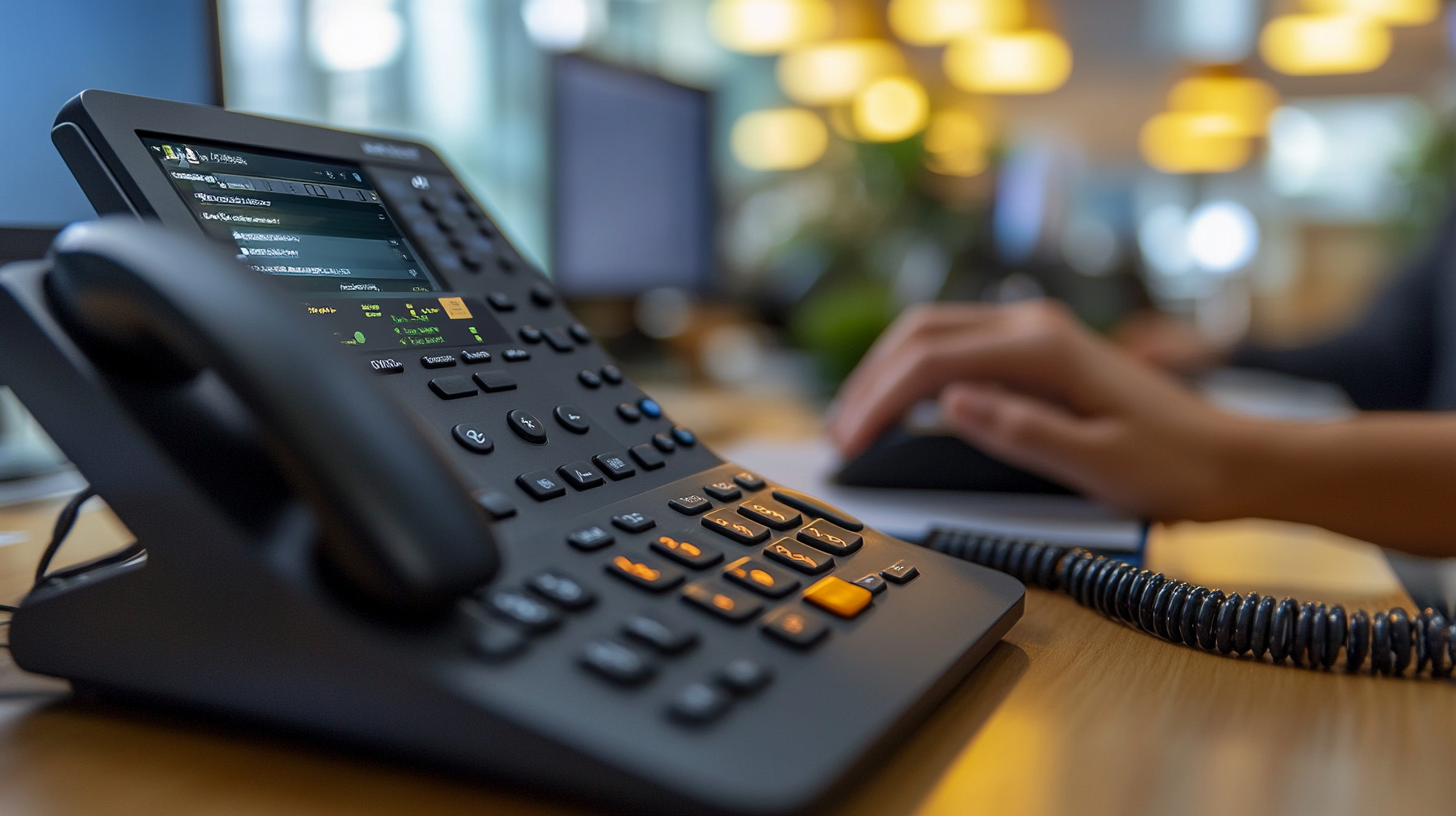Imagine your VoIP system as a fortress standing against a myriad of cyber threats. You need more than just high walls; you need a complete set of defenses. From encryption and network segmentation to robust firewalls and intrusion detection, each layer of protection plays an essential role. But how do you decide which measures are the most effective? And what about those advanced protocols and monitoring systems that promise to elevate your security game? Let’s explore the top 10 advanced threat protections that will fortify your VoIP telephony against evolving cyber threats.
Table of Contents
ToggleKey Takeaways
- Implement SRTP and TLS to encrypt voice data and SIP messages.
- Use VLANs to isolate and prioritize VoIP traffic for enhanced security.
- Deploy Intrusion Detection and Prevention Systems (IDPS) for real-time threat monitoring.
- Conduct regular security audits and update encryption algorithms and keys.
- Utilize Deep Packet Inspection (DPI) to detect and block malicious payloads.
Encryption
Encryption is one of the most essential tools for securing VoIP communications against unauthorized access and eavesdropping. When you use data encryption, you guarantee that any data transmitted over VoIP is converted into a secure format that can only be decoded by authorized parties. This process involves transforming plain text into ciphertext using algorithms that are highly impossible to crack without the correct decryption key.
For robust network security, you should implement strong encryption protocols like Secure Real-time Transport Protocol (SRTP) and Transport Layer Security (TLS). SRTP encrypts the actual voice data, while TLS secures the signaling data that sets up and manages VoIP calls. By employing these protocols, you effectively mitigate risks such as man-in-the-middle attacks and data breaches.
It’s also essential to regularly update your encryption algorithms and keys to stay ahead of evolving threats. Make sure that your VoIP provider supports modern encryption standards and offers automatic updates. Additionally, educating your team on the importance of data encryption and proper key management can significantly improve your overall network security. By prioritizing encryption, you’re taking critical steps to protect your VoIP communications from potential vulnerabilities.
Network Segmentation
To bolster VoIP security, you should isolate VoIP traffic from other network activities. By creating secure zones, you can limit the exposure of sensitive data and reduce the risk of unauthorized access. This segmentation helps guarantee that even if one part of your network is compromised, the VoIP system remains protected.
Isolate VoIP Traffic
When you isolate VoIP traffic through network segmentation, you greatly enhance the security and performance of your telephony system. By implementing VLANs (Virtual Local Area Networks), you can separate VoIP traffic from other data traffic on your network. This guarantees that voice packets get priority, reducing latency and improving call quality.
To start, you’ll need to configure VLANs specifically for VoIP devices, such as IP phones and VoIP gateways. This involves assigning a unique VLAN ID to these devices and configuring your network switches to recognize and prioritize this traffic. Implementing VLANs helps in mitigating congestion and guarantees that VoIP traffic remains unaffected by other bandwidth-heavy applications.
Next, enforce strict security policies on your VoIP VLAN. This includes setting up access control lists (ACLs) to restrict which devices can communicate within the VLAN. You’ll also want to apply firewall rules to protect against unauthorized access and potential attacks. These security policies act as a barrier, safeguarding your VoIP traffic from malicious activities.
Create Secure Zones
Creating protected zones through network segmentation enhances your VoIP telephony system’s security by isolating different types of traffic and reducing potential attack surfaces. By implementing a secure architecture, you can guarantee that threats affecting one segment don’t compromise the entire network. This structured approach minimizes risk and makes monitoring and managing traffic more efficient.
Here’s how you can create protected zones for your VoIP setup:
- Separate Voice and Data Traffic: Use VLANs to segregate VoIP traffic from regular data traffic. This guarantees that any issues in data networks don’t spill over to your voice communications.
- Dedicated Firewall Rules: Establish specific firewall rules for each network segment. This way, you can customize security protocols to the unique needs of each zone.
- Implement Access Controls: Restrict access to critical segments. Only authorized personnel should have access to sensitive areas of your VoIP architecture.
- Continuous Monitoring: Regularly monitor each segment for unusual activity. Use network monitoring tools to keep an eye on traffic patterns and detect potential threats early.
Firewalls
When you’re securing your VoIP telephony system, robust firewall features are essential. You’ll need to configure the firewall correctly to protect against unauthorized access and to monitor its activity continuously to detect any anomalies. Let’s explore the vital features you should look for, provide configuration tips, and discuss effective monitoring strategies.
Essential Firewall Features
Firewalls are vital for protecting VoIP systems from unauthorized access and cyber threats. When you implement a firewall, you gain several benefits that enhance your VoIP security. First, firewalls act as a barrier between your internal network and external threats, filtering out potential dangers before they reach your VoIP infrastructure. This security implementation is important to maintain the integrity and confidentiality of your communications.
Here are four key firewall features you should look for:
- Intrusion Detection and Prevention: Monitors traffic for suspicious activities and blocks potential intrusions in real-time.
- Application Layer Filtering: Examines the data being communicated to ensure it adheres to your security policies, preventing harmful traffic.
- Stateful Packet Inspection (SPI): Tracks the state of active connections and ensures that incoming packets are legitimate responses to outgoing requests.
- Unified Threat Management (UTM): Combines multiple security services, such as antivirus, anti-spyware, and content filtering, into one all-encompassing solution.
These features help you create a strong security framework that proactively defends your VoIP systems. By incorporating them into your firewall setup, you guarantee comprehensive protection against a wide array of cyber threats, enhancing the overall security of your VoIP telephony.
Firewall Configuration Tips
To maximize the effectiveness of the firewall features discussed, proper configuration is key to guaranteeing your VoIP system remains secure. Start with defining specific rules that allow only the necessary traffic for your VoIP services. Use firewall best practices by employing a principle of least privilege, making sure only essential ports are open and used.
First, segment your VoIP traffic from other types of network traffic. This enhances network security by isolating potential threats. Configure your firewall to block all inbound and outbound traffic by default, then create exceptions for trusted IP addresses and necessary protocols like SIP (Session Initiation Protocol) and RTP (Real-Time Protocol).
Next, enable and properly configure Stateful Packet Inspection (SPI) to track and validate the state of network connections. This ensures that only legitimate packets are allowed through. Implement intrusion detection and prevention systems (IDPS) to monitor and react to suspicious activities.
Lastly, regularly update your firewall firmware and review your configuration settings. This guarantees you’re protected against the latest vulnerabilities. By adhering to these firewall best practices, you’ll noticeably enhance your VoIP network security and protect your communications from potential threats.
Monitoring Firewall Activity
Monitoring firewall activity is vital for maintaining the security and integrity of your VoIP network. By actively overseeing your firewall, you can detect and mitigate potential threats before they compromise your system. Effective network monitoring goes beyond just setting up a firewall; it requires continuous scrutiny and analysis to guarantee robust protection.
Here are four key steps to enhance your firewall monitoring:
- Log Analysis: Regularly review firewall logs to identify unusual patterns or unauthorized access attempts. This kind of threat analysis helps you pinpoint vulnerabilities and take corrective actions promptly.
- Automated Alerts: Configure your firewall to send automated alerts for suspicious activities, such as multiple failed login attempts or unexpected traffic spikes. This enables real-time responses to potential threats.
- Traffic Inspection: Use deep packet inspection (DPI) to analyze the contents of data packets traversing your network. DPI helps identify and block malicious payloads that standard filters might miss.
- Periodic Audits: Conduct regular security audits to assess the firewall’s effectiveness. This includes testing different attack vectors to make sure your defenses are up-to-date against emerging threats.
Intrusion Detection
Intrusion detection plays a significant role in safeguarding VoIP telephony systems by identifying and mitigating unauthorized access attempts promptly. To effectively protect your VoIP infrastructure, you need to employ robust intrusion detection systems (IDS) that perform thorough threat analysis. This involves monitoring network traffic to identify patterns that may indicate malicious activities or breaches.
Implementing IDS is important for maintaining the integrity and confidentiality of your communications. By continuously analyzing data packets, intrusion detection systems can detect anomalies that deviate from established security protocols. This proactive approach allows you to respond to threats before they compromise your VoIP network.
For best protection, integrate both signature-based and anomaly-based IDS. Signature-based IDS rely on known threat signatures to identify attacks, while anomaly-based IDS detect deviations from normal network behavior. Combining these methods provides extensive coverage against both known and emerging threats.
Make sure your IDS is configured to alert you immediately upon detecting suspicious activity. This real-time response capability is essential for preventing potential damage. Regularly update your IDS and review security logs to ensure that your threat analysis remains current and effective. By prioritizing intrusion detection, you can greatly enhance the security of your VoIP telephony systems.
Secure Passwords
Securing the use of secure passwords is essential for safeguarding your VoIP telephony systems against unauthorized access. Strong passwords act as the first line of defense, and focusing on password complexity can markedly reduce the risk of breaches. Here’s a detailed approach to securing your VoIP passwords:
- Password Complexity: Use passwords that incorporate a mix of uppercase letters, lowercase letters, numbers, and special characters. Avoid common words and predictable patterns.
- Regular Changes: Change passwords periodically. This practice ensures that even if a password is compromised, the window for unauthorized access is minimized.
- Unique Passwords: Guarantee that each account has a unique password. Reusing passwords across different accounts amplifies the risk of a single breach compromising multiple systems.
- Account Lockout: Implement account lockout policies. After a certain number of failed login attempts, the account should be temporarily locked. This measure helps in thwarting brute force attacks.
Analyzing these steps reveals their critical role in enhancing your VoIP security. Password complexity makes it harder for attackers to guess passwords, and account lockout policies add an extra layer of protection. By adhering to these guidelines, you strengthen your system’s resilience against unauthorized access.
Regular Updates
Regular updates to your VoIP telephony systems are essential for maintaining robust security and peak performance. By consistently applying security patches, you’re addressing vulnerabilities that could be exploited by cyber threats. Software updates are designed not only to improve functionality but to strengthen your systems against new and evolving risks. These updates often include critical security patches that close loopholes and prevent potential breaches.
You should also conduct regular vulnerability assessments to identify weaknesses in your VoIP infrastructure. This proactive approach helps you stay ahead of threats and guarantees you’re compliant with industry-specific compliance regulations. Ignoring these updates can leave your systems exposed, making them easy targets for attackers.
Moreover, staying current with software updates ensures you’re benefiting from the latest features and performance enhancements. This keeps your VoIP telephony running smoothly and efficiently, minimizing downtime and operational disruptions. Regular updates also help you meet compliance regulations, which are often designed to guarantee that systems are secure and reliable.
Access Control
To safeguard your VoIP systems, you need robust access control mechanisms. Implement user authentication protocols to guarantee only authorized individuals can access the network, and use role-based permissions to limit what each user can do. This combination minimizes the risk of unauthorized access and potential security breaches.
User Authentication Protocols
When implementing VoIP telephony systems, robust user authentication protocols are essential for maintaining secure access control and protecting sensitive communications. User verification and identity validation are critical components that guarantee only authorized individuals gain access to the system.
To strengthen your VoIP security, consider implementing the following measures:
- Multi-Factor Authentication (MFA): Require users to provide two or more verification factors, such as passwords and one-time codes sent to their mobile devices.
- Biometric Authentication: Utilize fingerprint or facial recognition technologies to validate user identities, adding an extra layer of security.
- Token-Based Authentication: Implement hardware or software tokens that generate time-sensitive codes, guaranteeing that only users with the correct token can access the system.
- Secure Password Policies: Enforce strong, unique passwords that are regularly updated and include a mix of characters, numbers, and symbols.
Role-Based Permissions
Building on strong user authentication protocols, implementing role-based permissions guarantees that each user has access only to the specific VoIP features and data necessary for their role. By defining security roles, you can verify that employees only interact with the parts of the system relevant to their duties, drastically reducing the risk of unauthorized access or data breaches.
Start by identifying different user access levels within your organization. For instance, an admin might need full access to configure settings, while a customer service representative requires only limited access to call handling features. Implementing these tailored security roles minimizes the attack surface and assures sensitive data remains protected.
Next, integrate these role-based permissions into your VoIP system. Most modern VoIP platforms support this feature natively, allowing for seamless implementation. Regularly review and update these permissions to adapt to changing job roles or new security threats.
Furthermore, audit user access logs to detect any anomalies that could indicate a potential security breach. Effective access control not only fortifies your VoIP security posture but also enhances operational efficiency by streamlining user interactions with the system. Implement role-based permissions meticulously to maintain a robust, secure VoIP environment.
VoIP Security Protocols
VoIP security protocols play an important role in safeguarding your communication infrastructure against potential cyber threats. By implementing robust protocols, you enhance network security and maintain the integrity and confidentiality of your VoIP communications. Here are four critical VoIP security protocols you should consider:
- Secure Real-Time Transport Protocol (SRTP): This protocol encrypts voice data, making it challenging for attackers to eavesdrop on your conversations. SRTP is vital for preserving the privacy of your calls.
- Transport Layer Security (TLS): TLS secures the signaling part of VoIP communications. By encrypting the SIP (Session Initiation Protocol) messages, TLS prevents man-in-the-middle attacks and ensures that only authorized users can initiate and manage calls.
- IPsec (Internet Protocol Security): IPsec is used to protect data traffic across your VoIP network. It authenticates and encrypts each IP packet, providing a secure communication channel between devices and preventing unauthorized access.
- ZRTP (Zimmermann Real-Time Transport Protocol): ZRTP adds an additional layer of encryption to your VoIP calls. It uses a Diffie-Hellman key exchange to guarantee that even if an attacker intercepts the communication, they cannot decrypt the voice data.
Implementing these protocols strengthens your VoIP network security, safeguarding your business from potential cyber threats.
Traffic Monitoring
How can you safeguard your VoIP system remains secure and efficient? Traffic monitoring is key. By analyzing your network traffic, you can identify and mitigate threats before they impact your system. Utilize deep packet inspection (DPI) to scrutinize data packets beyond basic header information. DPI allows you to examine the packet’s content, revealing any anomalies or malicious activities that standard monitoring might miss.
Implementing threat intelligence services further enhances your traffic monitoring capabilities. These services provide real-time updates on emerging threats, enabling your system to adapt and defend against new vulnerabilities swiftly. By integrating threat intelligence, you guarantee your VoIP system is always one step ahead of potential attackers.
Regular traffic monitoring helps you spot unusual patterns, such as unexpected spikes in call volumes or data transfers, which could indicate security breaches or fraud attempts. Use specialized VoIP monitoring tools that offer detailed analytics and reports to keep a close eye on your network’s health.
Incorporating both deep packet inspection and threat intelligence into your traffic monitoring strategy assures a robust defense mechanism. This proactive approach not only secures your VoIP telephony but also maintains its efficiency and reliability.
Endpoint Protection
Securing your VoIP endpoints is crucial to safeguarding the entire communication network from potential threats. Without robust endpoint protection, your VoIP telephony system is vulnerable to cyberattacks that can disrupt service and compromise sensitive information. Implementing effective endpoint protection involves a blend of advanced security software and dynamic threat intelligence.
To enhance endpoint protection, consider these key strategies:
- Deploy Thorough Security Software: Use software that offers real-time protection against malware, phishing, and other malicious activities targeting VoIP devices.
- Leverage Threat Intelligence: Integrate threat intelligence services that provide updated information on emerging threats, helping you stay ahead of potential vulnerabilities.
- Implement Access Controls: Restrict access to VoIP endpoints using strong authentication methods and role-based permissions to minimize unauthorized usage.
- Regularly Update and Patch Systems: Keep all VoIP-related hardware and software up-to-date with the latest patches to close security gaps that attackers could exploit.
Frequently Asked Questions
How Can Voip Systems Be Protected Against Phishing Attacks?
To protect VoIP systems against phishing attacks, you should implement VoIP encryption to secure communications and use phishing prevention tools to identify and block malicious emails and links. Regularly train staff on recognizing and avoiding phishing attempts.
What Role Does User Training Play in Voip Security?
User training plays an important role in VoIP security. By enhancing user awareness and teaching security best practices, you can greatly reduce the risk of breaches. Well-trained users are your first line of defense against vulnerabilities.
Are There Specific Hardware Requirements for Secure Voip Deployment?
Yes, there are specific hardware requirements for secure VoIP deployment. Verify hardware compatibility with VoIP encryption standards. Invest in devices that support advanced encryption protocols to maintain a secure and reliable communication system.
How Do You Handle Voip Security in a Remote Work Environment?
To handle VoIP security in a remote work environment, you should implement network encryption to protect data and guarantee endpoint security to safeguard devices. Regularly update software and use strong passwords to enhance overall security.
Can Voip Security Measures Impact Call Quality?
Yes, VoIP security measures can impact call quality. Implementing encryption and firewalls might affect performance, but optimizing Quality of Service (QoS) settings can help maintain high call quality while ensuring robust security.
Final Thoughts
You’ve now seen how essential advanced threat protections are for VoIP telephony. By implementing measures like SRTP encryption and VLAN network segmentation, you can greatly reduce risks. Regular audits and secure VoIP protocols like IPsec bolster your defenses. Don’t overlook these protections; they guarantee your VoIP communications remain secure and resilient against evolving cyber threats.






